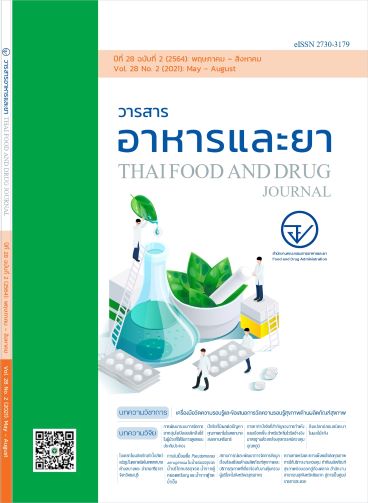การหาค่าปัจจัยที่สำคัญของการทำแห้งแบบเยือกแข็งสำหรับวัคซีนไวรัสอ้างอิงมาตรฐานด้วยกล้องจุลทรรศน์ควบคุมอุณหภูมิ
Main Article Content
บทคัดย่อ
ความสำคัญ: การทำแห้งแบบเยือกแข็งเป็นวิธีคงคุณสมบัติที่เหมาะสมสำหรับวัคซีนไวรัสอ้างอิงมาตรฐานที่ใช้ในการควบคุมคุณภาพวัคซีน การหาสภาวะในการทำแห้งแบบเยือกแข็งในสภาวะจริง ต้องใช้ปริมาณตัวอย่างมาก ใช้เวลานาน 1-5 วัน และต้องทดสอบหลายครั้งเพื่อปรับสภาวะให้เหมาะสม
วัตถุประสงค์: เพื่อพัฒนาการจัดเตรียมวัคซีนไวรัสอ้างอิงมาตรฐานโดยใช้กล้องจุลทรรศน์ควบคุมอุณหภูมิ โดยสังเกตความเปลี่ยนแปลงของตัวอย่างขณะจำลองสภาวะ อุณหภูมิ และความดันในการทำแห้งแบบเยือกแข็งเพื่อตรวจสอบอุณหภูมิที่เกิดการยุบตัว
วิธีการวิจัย: เตรียมสูตรตำรับ 4 สูตร มาตรวจสอบอุณหภูมิที่เกิดการยุบตัวภายใต้กล้อง นำค่าอุณหภูมิเฉลี่ยที่เกิดการยุบตัวมาคำนวณหาอุณหภูมิทำแห้งขั้นต้นเพื่อกำหนดสภาวะเครื่องทำแห้งแบบเยือกแข็ง ทำการทดลองทำแห้งในสภาวะจริง และนำตัวอย่างที่ได้มาทดสอบลักษณะทางกายภาพ ค่าความแรง และความคงตัว
ผลการศึกษา: อุณหภูมิทำแห้งขั้นต้นที่คำนวณได้ของสูตรตำรับที่ 1, 2, 3 และ 4 คือ -27.8, -28.8, -29.0 และ -28.8 0C ตามลำดับ โดยทั้ง 4 สูตรมีความใกล้เคียงกันไม่มีความแตกต่างอย่างมีนัยสำคัญทางสถิติ เมื่อนำวัคซีนไวรัสอ้างอิงมาตรฐานจากการทำแห้งมาทดสอบลักษณะทางกายภาพ ปริมาณน้ำ ระยะเวลาในการละลาย ความคงตัว และร้อยละของการสูญเสียไวรัส พบว่าผลการทดสอบทั้ง 4 สูตร มีลักษณะที่ดีและมีค่าอยู่ในเกณฑ์กำหนดของแต่ละรายการทดสอบ ยกเว้นการทดสอบความคงตัวที่เก็บที่ 37 °C เป็นเวลา 7 วัน พบว่าสูญเสียค่าความแรงของไวรัสในระดับสูงสุด 1.54 log PFU/0.5 ml
สรุป: จากงานวิจัยนี้จะเห็นได้ว่าวิธีดังกล่าวมีความเหมาะสมในการกำหนดอุณหภูมิทำแห้งขั้นต้น คืออุณหภูมิไม่สูงเกินจนตัวอย่างเกิดการยุบตัว และไม่ต่ำเกินไปที่ทำให้ระยะเวลาในการทำแห้งแบบเยือกแข็งเพิ่มขึ้น ตลอดจนใช้ในการหาสูตรตำรับและสภาวะที่เหมาะสม โดยลดเวลาเหลือ 0.5–2 ชั่วโมง และใช้ปริมาณตัวอย่างน้อยมากถึงระดับไมโครลิตร ซึ่งเป็นไปตามวัตถุประสงค์ของงานวิจัย และมีความเหมาะสมที่กำหนดเป็นมาตรฐานของวิธีการหาค่าปัจจัยที่สำคัญของการทำแห้งแบบเยือกแข็งสำหรับวัคซีนไวรัสอ้างอิงมาตรฐานด้วยกล้องจุลทรรศน์ควบคุมอุณหภูมิ
Article Details

อนุญาตภายใต้เงื่อนไข Creative Commons Attribution-NonCommercial-NoDerivatives 4.0 International License.
เอกสารอ้างอิง
Rey L, May JC. Freeze-drying/ lyophilization of pharmaceutical and biological products, 2nd ed. NewYork: Marcel Dekker; 2004.
Singh SK, Upadhyay RC, Yadav MC, Tiwari M. Development of a novel lyophilization protocol for preservation of mushroom mycelial cultures, Curr Sci [Internet]. 2004 [cited 2021 Apr 23]; 87(5):568-70. Available from: https://www.researchgate.net/profile/Dr-Mahesh-Yadav/publication/282819934_Development_of_a_novel_lyophilization_protocol_for_preservation_of_mushroom_mycelial_cultures/links/5697300308ae34f3cf1e1022/Development-of-a-novel-lyophilization-protocol-for-preservation-of-mushroom-mycelial-cultures.pdf
ปัณณธร ภัทรสถาพรกุล. เทคโนโลยีการทำแห้งแบบเยือกแข็ง (ตอนที่ 3). วารสารสมาคมเครื่องทำความเย็นไทย [อินเทอร์เน็ต]. 2548 [เข้าถึงเมื่อ 23 เม.ย. 2564];15:7-9. เข้าถึงได้จาก: https://tra.or.th/wp-content/uploads/2017/05/keep-kool-15.pdf
Ohtomo T, Yamada T, Yoshida K. Outermost-cell-surface changes in an encapsulated strain of Staphylococcus aureus after preservation by freeze-drying. Appl Environ Microbiol [Internet]. 1988 [cited 2021 Apr 23]; 54(10):2486-91. Available from: https://aem.asm.org/content/aem/54/10/2486.full.pdf
Naddafi K, Moosavi GH, Mesdaghinia AR. Evaluation of lyophilization effects on operational parameters and characteristics of activated sludge. Iranian J Env Health Sci Eng [Internet]. 2004 [cited 2021 Apr 23]; 1(1):20-5. Available from:https://www.sid.ir/FileServer/JE/102620040109.pdf
Jennings TA. Lyophilization: introduction and basic principles. NewYork: Informa Healthcare USA; 2008.
อัศจรรย์ อาเมน, จิรเดช ปัจฉิม, พรหมฉัตร เจริญพัฒน์, ณัฐกานต์ มิ่งงามทรัพย์, สุภาพร ภูมิอมร. การศึกษาหาสูตรตำรับที่เหมาะสมในการทำแห้งวัคซีนคางทูมอ้างอิงมาตรฐาน. วารสารกรมวิทยาศาสตร์การแพทย์. 2554;53(2):97-112.
Zhai S, Taylor R, Sanches R. Slater NKH. Measurement of lyophilisation primary drying rates by freeze-drying microscopy. Chem Eng Sci 2003;58(11):2313–23.
Kevin R. Advanced uses of freeze drying microscopy (fdm) for product formulation and lyo-cycle development [Internet]. 2007 [cited 2019 Sep 1]. Available from: http://docplayer.net/39803625-Advanced-uses-of-freeze-drying-microscopy-fdm-for-product-formulation-and-lyo-cycle-development.html
Barresi AA, Ghio S, Fissore D, Pisano R. Freeze‐drying of pharmaceutical excipients close to collapse temperature: influence of the process conditions on process time and product quality. Drying Technology 2009;27(6):805-16.
Ross C, Gaster T, Ward K. The Importance of Critical Temperatures in the Freeze Drying of Pharmaceutical Products [Internet]. 2011 [cited 2019 Sep 1]. Available from: http://biopharma.co.uk/intelligent-freeze-drying/wp-content/uploads/sites/2/2011/07/Importance_critical_temps_Resized-v1.pdf
Kasraian K, Spitznagelb TM, Juneau J, Yim K. Characterization of the Sucrose/Glycine/ Water System by Differential Scanning Calorimetry and Freeze-Drying Microscopy, Pharmaceut Dev Tech 1998;3(2):233-9.
Tang X, Pikal MJ. Design of freeze-drying processes for pharmaceuticals: practical advice. Pharmaceut Res 2004;21:191–200.
Lu, X, Pikal M. Freeze-drying of mannitol-trehalose-sodium chloride-based formulations: The impact of annealing on dry layer resistance to mass transfer and cake structure. Pharmaceut Dev Tech 2004;9:85–95.
Haeusera C, Goldbach P, Huwyler J, Friess W, Allmendinger A. Impact of dextran on thermal properties, product quality attributes, and monoclonal antibody stability in freeze-dried formulations. Eur. J. Pharm. Biopharm 2020;24(147):45-56.
Meister E, Gieseler H. Freeze-Dry Microscopy of Protein/Sugar Mixtures: Drying Behavior, Interpretation of Collapse Temperatures and a Comparison to Corresponding Glass Transition Data. J Pharmaceut Sci 2009;98(9):3072-87.
Pikal MJ, Shah S. The collapse temperature in freeze drying: Dependence on measurement methodology and rate of water removal from the glassy phase. Int J Pharm 1990;62:165-86.
Rambhatla S, Obert JP, Luthra S, Bhugra C, Pikal MJ. Cake shrinkage during freeze drying: A combined experimental and theoretical study. Pharmaceut Dev Tech 2005;10(1):33-40.
WHO Expert Committee on Biological Standardization. Annex 7: Recommendations to assure the quality, safety and efficacy of Japanese encephalitis vaccines (live, attenuated) for human use [Internet]. 2014 [cited 2019 Sep 1]. Available from: https://www.who.int/biologicals/vaccines/JE-Recommendations_TRS_980_
Annex_7.pdf?ua=1
ณัฐกานต์ มิ่งงามทรัพย์, อัศจรรย์ อาเมน, สุภาพร ภูมิอมร. การทำแห้งไวรัสโรตาซีโรทัยป์เดี่ยวเชื้อเป็น เพื่อใช้เป็นวัคซีนอ้างอิงมาตรฐานของประเทศ. วารสารวิชาการสาธารณสุข 2559;25(5):897-907.


